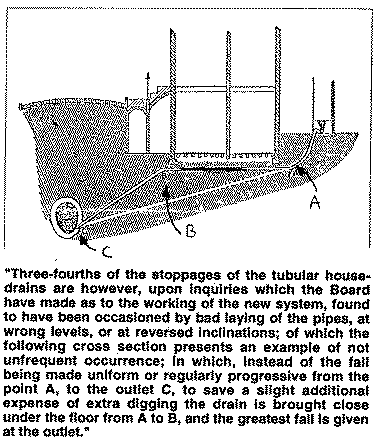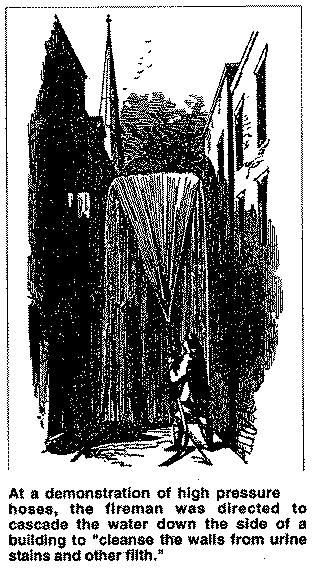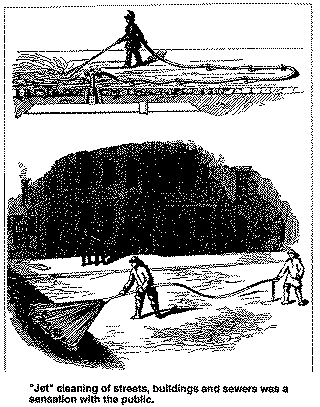
A Glimpse Into London's Early Sewers
Reprinted from Cleaner magazine
PART II
Cleaning Up London's Drains and Sewers
BY MARY GAYMAN
Once the idea of using water to carry away human wastes was accepted,
LondonŐs Commission of Sewers set out to drain the city by means of large egg-
shaped tubular sewers fed by "tubular pipes" from individual homes and
businesses.
After many studies, it became evident that interior "smoothness" of the
pipe was a critical factor in moving waterborne wastes along the new system.
Glazed or salt clay was said to be far superior to other materials. When
properly installed at the right slope, with correct sizing and even
workmanship, the commission argued that "the use of glazed clay tubes has been
hitherto remarkably successful." By 1847 Commission reports show that "between
10 and 11 miles of earthenware pipes are sold weekly, which is at the rate of
2,600 miles of new sewers each year."
"Three fourths of the stoppages of tubular house drains were found to
have been occasioned by bad laying of the pipes, wrong levels, and reversed
inclinations. Many pipe drains have been so laid as to create obstructions and
these failures, though the causes are obvious and gross, have been eagerly
held forth as proofs of failure of the principle."
Dr. Dalby, a physician reporting to the commissioners, claimed that
"choking of the pipe" was the likely source of three cases of typhus in one
household.
It was said that "it would be better for the inhabitants of many houses
to pay for new tubular drains every year than to run the risk of having them
stopped up every month and than to have the large drains detaining and
spreading the deposit and facilitating decomposition within the walls and
beneath the floors of their dwellings."
Acceptance of the entire drainage idea was in question after the cholera
epidemic hit in 1849. As the public panic grew, "every pipe makerŐs yard was
cleared out."
 During this period, pipe was made by "persons not overly scrupulous,
eagerly purchased, and hastily laid by parties utterly ignorant of any role of
correct drainage," creating doubts about the validity of the new scheme. The
commission found itself having to defend the continuation of conversion from
cesspits to tubular drains.
Poor design and bad workmanship led to frequent and expensive failures
and digups from stoppages and collapses. In most residences, the house was
drained from the back, through the house into the sewer placed in the center
of the front street.
A study of pipe construction found that "offensive and noxious matter
was carried completely under the house, instead of directly away from it, and
the chances of stoppages were increased in proportion to the increased
frictional area and to the diminution of the fall."
"By these ignorant and mischievous arrangements, when a stoppage does
occur, it can frequently be remedied only by taking up the floor boards of the
front as well as the back room, and opening of the foot and carriage pavement
to the sewer in the centre of the street, all which work must be done at great
inconvenience and at oppressive expense."
Sewer gases from the main sewer came back up into the houses. Doctors
visiting the sick reported "offensive smells and excessive state of impurity
in the air at the dwelling houses." These "miasmas" were blamed as typhoid
fever and cholera continued to plague the city." Meanwhile, large sewers in
the street were being redesigned of brick in the new "egg" shape.
During this period, pipe was made by "persons not overly scrupulous,
eagerly purchased, and hastily laid by parties utterly ignorant of any role of
correct drainage," creating doubts about the validity of the new scheme. The
commission found itself having to defend the continuation of conversion from
cesspits to tubular drains.
Poor design and bad workmanship led to frequent and expensive failures
and digups from stoppages and collapses. In most residences, the house was
drained from the back, through the house into the sewer placed in the center
of the front street.
A study of pipe construction found that "offensive and noxious matter
was carried completely under the house, instead of directly away from it, and
the chances of stoppages were increased in proportion to the increased
frictional area and to the diminution of the fall."
"By these ignorant and mischievous arrangements, when a stoppage does
occur, it can frequently be remedied only by taking up the floor boards of the
front as well as the back room, and opening of the foot and carriage pavement
to the sewer in the centre of the street, all which work must be done at great
inconvenience and at oppressive expense."
Sewer gases from the main sewer came back up into the houses. Doctors
visiting the sick reported "offensive smells and excessive state of impurity
in the air at the dwelling houses." These "miasmas" were blamed as typhoid
fever and cholera continued to plague the city." Meanwhile, large sewers in
the street were being redesigned of brick in the new "egg" shape.
Water As a Cleaning Tool
 An experiment on street cleaning with fire hoses led to the first use of
the jet hose to clean street surfaces, drainage slots and sewers. At a
demonstration of high pressure hoses, the fireman was directed to cascade the
water down the side of a building to "cleanse the walls from urine stains and
other filth."
The Mayor of London asked that the hose be directed at the pavement
(deep in horse manure) to see how effectively it could be removed from the
cobbled surfaces.
Since the sewer drain in the center of the street carried cesspit wastes
as well as horse manure and street sweepings, the grid on top of the sewer was
removed and the slop was flushed with high pressure water.
The commissioners were amazed to see the buildings, streets and sewers
so clean and rushed back to breathlessly report this new wonder to the
Commission of Sewers.
"The Mayor, the Town Regent and many other influential persons were
present. The hose was of leather, 3 inches in diameter and about 60 yards
long, with a discharge pipe 1 and 1/4 inch in diameter. The carriageway is
from 20 to 24 feet wide and about 150 yards long. It was washed almost as
clean as a house floor within five minutes."
"The surface of the reservoir is 350 feet higher than the point of
discharge, and 2557 yards from it. The time occupied and the efficacy of the
cleansing experiment depended, of course on the quantity and force of the
water."
An all out effort was launched to determine the cost of "cleansing with
water" versus the labor for sweeping, shoveling, scrubbing and hauling away
caked-on manures and other wastes. It was proven that water was cheaper by
far.
Once this report was made on this method, the Commission of Sewers
conducted many tests to determine the pressures, volume of water and effect of
hoses lengths on pressures at the nozzles.
"It will be obvious that this saving of time and labour would also be of
great importance as affecting the cost of any system of public cleansing by
the agency water."
An experiment on street cleaning with fire hoses led to the first use of
the jet hose to clean street surfaces, drainage slots and sewers. At a
demonstration of high pressure hoses, the fireman was directed to cascade the
water down the side of a building to "cleanse the walls from urine stains and
other filth."
The Mayor of London asked that the hose be directed at the pavement
(deep in horse manure) to see how effectively it could be removed from the
cobbled surfaces.
Since the sewer drain in the center of the street carried cesspit wastes
as well as horse manure and street sweepings, the grid on top of the sewer was
removed and the slop was flushed with high pressure water.
The commissioners were amazed to see the buildings, streets and sewers
so clean and rushed back to breathlessly report this new wonder to the
Commission of Sewers.
"The Mayor, the Town Regent and many other influential persons were
present. The hose was of leather, 3 inches in diameter and about 60 yards
long, with a discharge pipe 1 and 1/4 inch in diameter. The carriageway is
from 20 to 24 feet wide and about 150 yards long. It was washed almost as
clean as a house floor within five minutes."
"The surface of the reservoir is 350 feet higher than the point of
discharge, and 2557 yards from it. The time occupied and the efficacy of the
cleansing experiment depended, of course on the quantity and force of the
water."
An all out effort was launched to determine the cost of "cleansing with
water" versus the labor for sweeping, shoveling, scrubbing and hauling away
caked-on manures and other wastes. It was proven that water was cheaper by
far.
Once this report was made on this method, the Commission of Sewers
conducted many tests to determine the pressures, volume of water and effect of
hoses lengths on pressures at the nozzles.
"It will be obvious that this saving of time and labour would also be of
great importance as affecting the cost of any system of public cleansing by
the agency water."
 Commission engineers also calculated the loss of pressure from the
outlet or pump to the "nozzle" at one pound per lineal foot of hose. Operators
of jet cleaners today must also compensate for pressure loss. Longer hoses
need increased pump pressures to deliver optimum results.
Commission engineers also calculated the loss of pressure from the
outlet or pump to the "nozzle" at one pound per lineal foot of hose. Operators
of jet cleaners today must also compensate for pressure loss. Longer hoses
need increased pump pressures to deliver optimum results.
Pipe Sizing Critical to Assure Flow of Wastes in Water
Hydraulic action of water within the pipe was calculated to size pipe
for maximum flow characteristics. Eventually the standard was set at 3" for
laterals, leading to 9" intermediate pipe and finally to the main, which was
deemed most effective at 75 times the area of the lateral and 8-1/3 the area
for the intermediate pipe.
The development of egg shaped brick sewers may have come from the
existing V-shaped street and sewer drains which were gradually covered with
arched brick to enclose the open trench. In the next of this series the
distinctive characteristics and benefits of egg shaped sewer channels will be
discussed.
Trial and error eventually settled on the ratio of sizes which remain at
3" for laterals in the UK and in much of Canada. It is interesting to note
that the Uniform Plumbing Code for California now prefers 3" laterals for new
houses to compensate for the low flow devices mandated as water conservation
devices.
Water Consumption Key to Estimating Sewer Loads
The 1841 census showed that there were 270,000 houses in the metropolis.
Based on this data, commission engineers made the following dispute of water
usage and drainage needs.
"Now, if each home were to have at least a 9 inch drain, and you and
other architects recommend, it appears that the area of the stream or river
required to keep them full and flowing would be a stream 1,132 feet in width
by 105 in depth ... Yes?
"It is estimated that a supply of water for the whole of the metropolis,
supposing each house to have a supply of 125 gallons per diem, or 25 gallons
per head (5 per household) would be given by a circular tunnel or aqueduct of
proportionate size to your number of houses, say, one fourth.
"Such being the estimate of size of conduits required to bring in water,
it is presumed that the sectional areas of the drains and sewers would not be
required of vastly greater size, supposing them to have as good a fall, the
carry away the same water."
"It is stated that the smaller the pipe is, generally, the less likely
will deposit accumulate. What is your opinion on the subject?"
"My opinion is this; I will take the case of the washer to the sink
being open and the cook throwing down anything that comes to hand; it comes
against a 4 inch pipe and it blocks completely up; but the end of a cabbage
stalk will pass into the 9 inch drain, and there it will lie and decompose."
Therefore, the chief, if not the only reason assigned for making the
intermediate drain at 9 inches diameter, is that of preventing it stopping or
choking, an effect which its large size and sluggish flow almost inevitably
occasions."
The arguments as to cleaning and gravity flow lead to countless studies
of the power of water to suspend and remove solids. It was generally agreed
that a wide flat channel (like that of a meandering river) tended to
accumulate sediment, while a narrow channel carrying the same volume of water
was purged of sediment.
The one would deposit silt or sand, the other would most certainly
remove both.
The egg shaped sewer promised both capacity at storm flows and self
cleaning flows at low levels of use.
==
Caption Text, for those without graphical browsers:
1. "Three-fourths of the stoppages of the tubular house-drains are however,
upon inquiries which the Board have made as to the working of the new system,
found to have been occasioned by bad laying of the pipes, at wrong levels,
or at reversed inclinations; of which the following cross section presents an
example of not unfrequent occurrence; in which, instead of the fall being made
uniform or regularly progressive from the point A, to the outlet C, to save a
slight additional expense of extra digging the drain is brought close under the
floor from A to B, and the greatest fall is given at the outlet."
2. At a demonstration of high pressure hoses, the fireman was directed to
cascade the water down the side of a building to "cleanse the walls from urine
stains and other filth."
3. "Jet" cleaning of streets, buildings and sewers was a sensation with the public.
Republished courtesy of Cleaner Magazine, a publication of Cole Publishing Inc., POB 220, Three Lakes WI 54562, tel. 800-257-7222 or 715-546-3346, and author Mary Gayman.
 Return to the Sewer History area of the SwopNet Engineering Databank. You will find Part 3 of the Sewers of London history there, as well as the Thomas Crapper photo site.
Return to the Sewer History area of the SwopNet Engineering Databank. You will find Part 3 of the Sewers of London history there, as well as the Thomas Crapper photo site.

During this period, pipe was made by "persons not overly scrupulous, eagerly purchased, and hastily laid by parties utterly ignorant of any role of correct drainage," creating doubts about the validity of the new scheme. The commission found itself having to defend the continuation of conversion from cesspits to tubular drains. Poor design and bad workmanship led to frequent and expensive failures and digups from stoppages and collapses. In most residences, the house was drained from the back, through the house into the sewer placed in the center of the front street. A study of pipe construction found that "offensive and noxious matter was carried completely under the house, instead of directly away from it, and the chances of stoppages were increased in proportion to the increased frictional area and to the diminution of the fall." "By these ignorant and mischievous arrangements, when a stoppage does occur, it can frequently be remedied only by taking up the floor boards of the front as well as the back room, and opening of the foot and carriage pavement to the sewer in the centre of the street, all which work must be done at great inconvenience and at oppressive expense." Sewer gases from the main sewer came back up into the houses. Doctors visiting the sick reported "offensive smells and excessive state of impurity in the air at the dwelling houses." These "miasmas" were blamed as typhoid fever and cholera continued to plague the city." Meanwhile, large sewers in the street were being redesigned of brick in the new "egg" shape.
![]() Return to the Sewer History area of the SwopNet Engineering Databank. You will find Part 3 of the Sewers of London history there, as well as the Thomas Crapper photo site.
Return to the Sewer History area of the SwopNet Engineering Databank. You will find Part 3 of the Sewers of London history there, as well as the Thomas Crapper photo site.